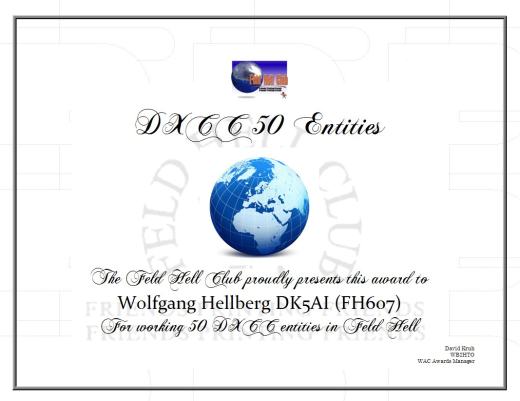Hellschreiber – what’s that?
 The Hellschreiber or Feldhellschreiber was a facsimile-based teleprinter invented by the German engineer Dr. Rudolf Hell (*19.12.1901 – +11.3.2002). It was developed at the end of the 1920’s, and has the advantage of being capable of providing intelligable communication even under very poor radio conditions.
The Hellschreiber or Feldhellschreiber was a facsimile-based teleprinter invented by the German engineer Dr. Rudolf Hell (*19.12.1901 – +11.3.2002). It was developed at the end of the 1920’s, and has the advantage of being capable of providing intelligable communication even under very poor radio conditions.
Nowadays using computers with sound cards, its easy to emulate the Hell mode. The resulting mode is referred to as Hellschreiber, Feld-Hell, or simply Hell.
Hellschreiber transmits text by dividing each column into 7 pixels, and transmitting them sequentially, starting at the lowest pixel. A black pixel is transmitted as a signal, and a white pixel is transmitted as silence. This takes place at a rate of 122.5 baud and needs a minimum bandwidth of 61 Hz (!!!). In contrast to the RTTY machine, in which received pulses determine the character to be printed, the Hellschreiber uses the transmitted pulses to directly write images of characters on paper tape. Thus, Hell writing could be considered a simple form of facsimile, covering seven image lines per character, with seven elements per line.
Some self explaining prints from Hell Contest December 30./31., 2006
![]()
![]()
![]()
![]()
![]()
![]()
Another nice QSO with Alain from Libreville / Gabon
![]()
Feld Hell Frequencies
80m 3.582 … 3.589 kHz
40m 7.030 … 7.040 kHz
7.075 … 7.082 kHz
30m 10.135 … 10.145 kHz
20m 14.063 … 14.079 kHz
17m 18.101 … 18.107 kHz
15m 21.063 … 21.070 kHz
12m 24.920 … 24.925 kHz
10m 28.063 / 28.070 kHz — 28.100 … 28.110 kHz preferred

Working 50 DXCC entities in Feld Hell Mode

First “Worked All States” Award using Feld Hell Mode outside USA
